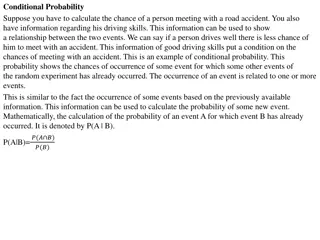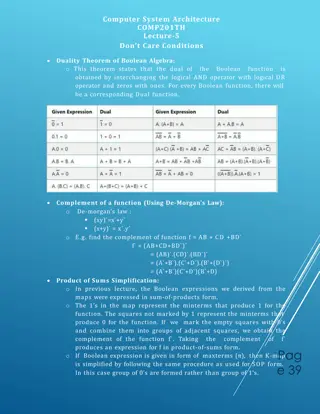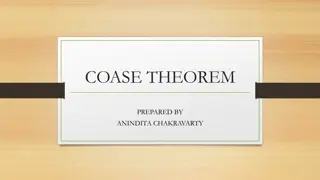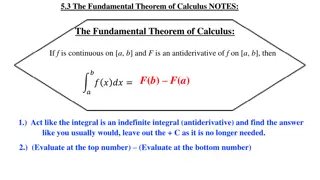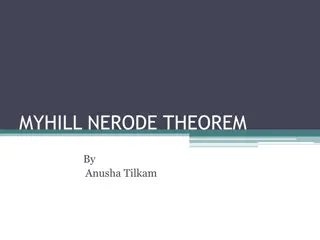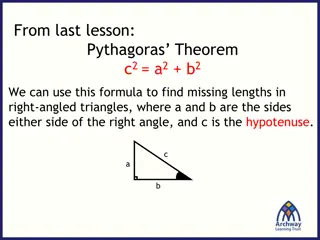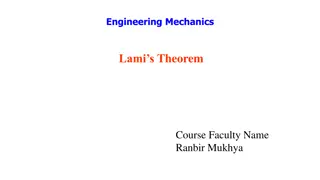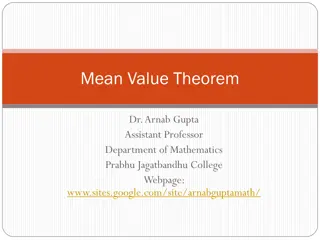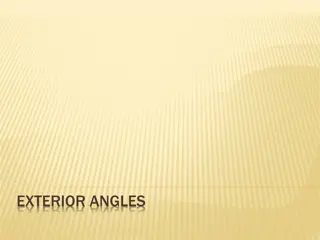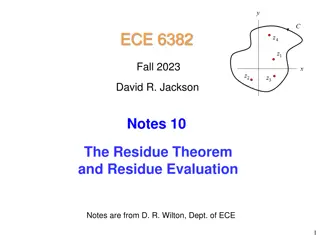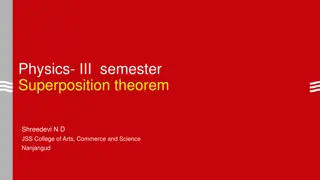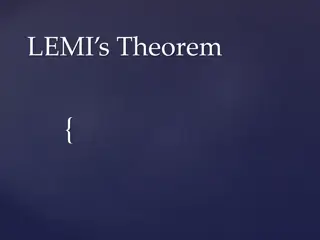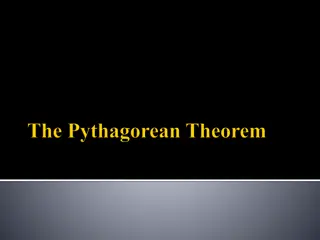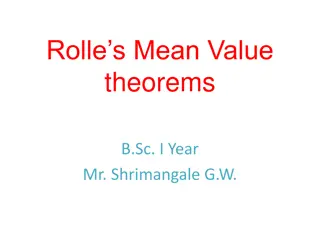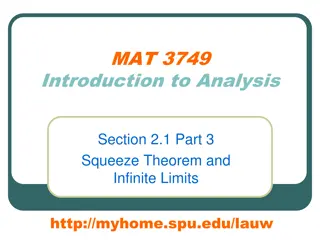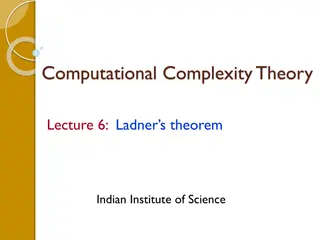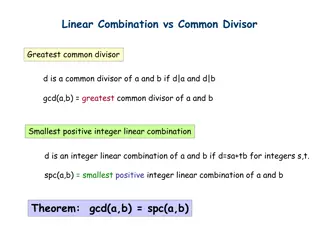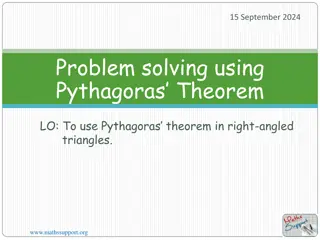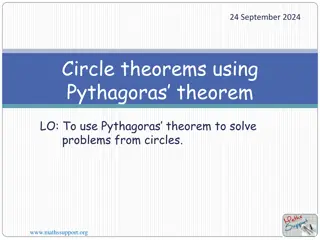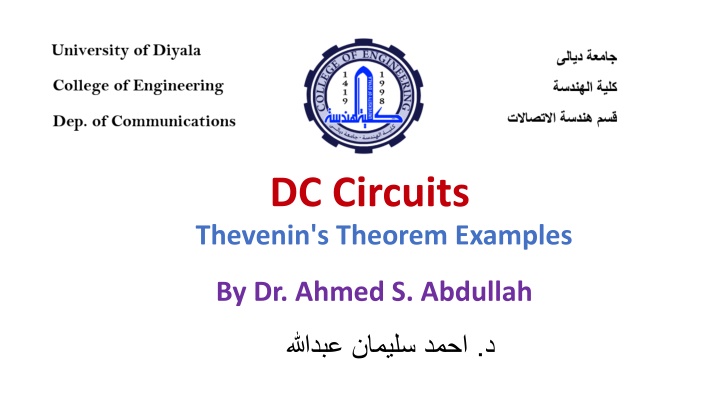
Thevenin's Theorem Circuit Analysis Example Solution
Explore the application of Thevenin's theorem in analyzing a circuit to find the current through a specific element. Follow step-by-step solution and calculations for a better understanding of DC circuits.
Download Presentation

Please find below an Image/Link to download the presentation.
The content on the website is provided AS IS for your information and personal use only. It may not be sold, licensed, or shared on other websites without obtaining consent from the author. If you encounter any issues during the download, it is possible that the publisher has removed the file from their server.
You are allowed to download the files provided on this website for personal or commercial use, subject to the condition that they are used lawfully. All files are the property of their respective owners.
The content on the website is provided AS IS for your information and personal use only. It may not be sold, licensed, or shared on other websites without obtaining consent from the author.
E N D
Presentation Transcript
DC Circuits Thevenin's Theorem Examples By Dr. Ahmed S. Abdullah .
Thevenin's Theorem EXAMPLE 1: Use the Thevenin theorem to find the current through 3 for the circuit of figure shown.
Thevenin's Theorem EXAMPLE 1: Use the Thevenin theorem to find the current through 3 for the circuit of figure shown. Solution:- Step 1 and 2:-
Thevenin's Theorem EXAMPLE 1: Use the Thevenin theorem to find the current through 3 for the circuit of figure shown. Solution:- Step 1 and 2:-
Thevenin's Theorem EXAMPLE 1: Use the Thevenin theorem to find the current through 3 for the circuit of figure shown. Solution:- Step 3:-
Thevenin's Theorem EXAMPLE 1: Use the Thevenin theorem to find the current through 3 for the circuit of figure shown. Solution:- Step 3:-
Thevenin's Theorem EXAMPLE 1: Use the Thevenin theorem to find the current through 3 for the circuit of figure shown. Solution:- Step 3:-
Thevenin's Theorem EXAMPLE 1: Use the Thevenin theorem to find the current through 3 for the circuit of figure shown. Solution:- Step 3:-
Thevenin's Theorem EXAMPLE 1: Use the Thevenin theorem to find the current through 3 for the circuit of figure shown. Solution:- Step 3:- ???= ? + (? // 12 ) = ? + ? = 9
Thevenin's Theorem EXAMPLE 1: Use the Thevenin theorem to find the current through 3 for the circuit of figure shown. Solution:- Step 4:- ? = ?? ? = ? ?
Thevenin's Theorem EXAMPLE 1: Use the Thevenin theorem to find the current through 3 for the circuit of figure shown. Solution:- Step 4:- ? = ?? ? = ? ?
Thevenin's Theorem EXAMPLE 1: Use the Thevenin theorem to find the current through 3 for the circuit of figure shown. Solution:- Step 4:-
Thevenin's Theorem EXAMPLE 1: Use the Thevenin theorem to find the current through 3 for the circuit of figure shown. Solution:- Step 4:- ???= ? ? + ??
Thevenin's Theorem EXAMPLE 1: Use the Thevenin theorem to find the current through 3 for the circuit of figure shown. Solution:- Step 4:-
Thevenin's Theorem EXAMPLE 1: Use the Thevenin theorem to find the current through 3 for the circuit of figure shown. Solution:- Step 4:- ??= ? ?? = ?? ? ? ? = ?? ?
Thevenin's Theorem EXAMPLE 1: Use the Thevenin theorem to find the current through 3 for the circuit of figure shown. Solution:- Step 4:- Applying the voltage divider rule, ?? ? ? + ? + ? =??? ? =?? ??= ? ? ?? = ??
Thevenin's Theorem EXAMPLE 1: Use the Thevenin theorem to find the current through 3 for the circuit of figure shown. Solution:- Step 4:- ???= ? ? + ?? = ? ? + ? ? = ?? ?
Thevenin's Theorem EXAMPLE 1: Use the Thevenin theorem to find the current through 3 for the circuit of figure shown. Solution:- Step 5:- ?? = 9 ??? ??= ???+ ?? ?? = 12? ??= 3 ?? ? ? + ? = ?? ??= ? ? ??=
Thevenin's Theorem EXAMPLE 2: Use the Thevenin theorem to find the current through 6 for the circuit of figure shown.
Thevenin's Theorem EXAMPLE 2: Use the Thevenin theorem to find the current through 6 for the circuit of figure shown. Solution:- Step 1 and 2:-
Thevenin's Theorem EXAMPLE 2: Use the Thevenin theorem to find the current through 6 for the circuit of figure shown. Solution:- Step 3:-
Thevenin's Theorem EXAMPLE 2: Use the Thevenin theorem to find the current through 6 for the circuit of figure shown. Solution:- Step 3:-
Thevenin's Theorem EXAMPLE 2: Use the Thevenin theorem to find the current through 6 for the circuit of figure shown. Solution:- Step 3:-
Thevenin's Theorem EXAMPLE 2: Use the Thevenin theorem to find the current through 6 for the circuit of figure shown. Solution:- Step 3:-
Thevenin's Theorem EXAMPLE 2: Use the Thevenin theorem to find the current through 6 for the circuit of figure shown. Solution:- Step 3:- ???= ?
Thevenin's Theorem EXAMPLE 2: Use the Thevenin theorem to find the current through 6 for the circuit of figure shown. Solution:- Step 4:-
Thevenin's Theorem EXAMPLE 2: Use the Thevenin theorem to find the current through 6 for the circuit of figure shown. Solution:- Step 4:- ???= ? ??
Thevenin's Theorem EXAMPLE 2: Use the Thevenin theorem to find the current through 6 for the circuit of figure shown. Solution:- Step 4:- ???= ? ?? ?? = ?? ? = ??
Thevenin's Theorem EXAMPLE 2: Use the Thevenin theorem to find the current through 6 for the circuit of figure shown. Solution:- Step 4:- ???= ? ?? ?? = ?? ? = ?? ???= ?? ? = ??
Thevenin's Theorem EXAMPLE 2: Use the Thevenin theorem to find the current through 6 for the circuit of figure shown. Solution:- Step 5:- ?? = 2 ??? ??= ??= 6 ???+ ?? ?? = 8? ? ? ? ?= ? ? ??= ? + ? =
Thevenin's Theorem EXAMPLE 3: Use the Thevenin s theorem to find the current through the branch a-bfor the circuit shown.
Thevenin's Theorem EXAMPLE 3: Use the Thevenin s theorem to find the current through the branch a-bfor the circuit shown. Solution:- ???
Thevenin's Theorem EXAMPLE 3: Use the Thevenin s theorem to find the current through the branch a-bfor the circuit shown. Solution:- ???
Thevenin's Theorem EXAMPLE 3: Use the Thevenin s theorem to find the current through the branch a-bfor the circuit shown. Solution:- ??? ???= (? + ?? )// 27 ) = ?? // 27 = ??.?
Thevenin's Theorem EXAMPLE 3: Use the Thevenin s theorem to find the current through the branch a-bfor the circuit shown. Solution:- ???
Thevenin's Theorem EXAMPLE 3: Use the Thevenin s theorem to find the current through the branch a-bfor the circuit shown. Solution:- ??? ?? = ?27 = ?1 27 Applying the current divider rule to find I1, ? (23 ) =(18?)(23 ) 54 ?1= = 7.67 ? 23 + 27 + 4 ?27 = ?1 27 = 7.67 ? 27 = 207 V ?? = ?27 = 207 ?
Thevenin's Theorem EXAMPLE 3: Use the Thevenin s theorem to find the current through the branch a-bfor the circuit shown. Solution:- ??=??? ??? ???+ ?? ??=??? ? ???? ??.? + ?? = ?? ??.?= ?.?? ?
References Boylestad, Robert L. Introductory circuit analysis. Pearson Education, 2010. Robbins, Allan H., and Wilhelm C. Miller. Circuit analysis: Theory and practice. Cengage Learning, 2012. Sadiku, Matthew NO, and Chales K. Alexander. Fundamentals of electric circuits. McGraw-Hill Higher Education, 2007.

